Italian food has a reputation for being very rough and ready, with its hearty stews, soups and pastas that Italian grandmothers throw together with yesterday's bread and ingredients so ripe that they aren't much good for anything else. This sort of cooking seems rural and pastoral in contrast to the haute cuisine of French cooking, simple versus sophisticated.
However, I find that the simplicity of Italian cooking belies the very real skill needed to pull it off. Simple and heartfelt though it may be, it still requires the perfect balance of timing, tenderness and temerity to produce an inimitable risotto or squid-ink pasta.
Nowhere is this more evident than in Italian desserts. To make an ephemeral tiramisu is no mean feat, even though the ingredients are basic. One of my favourite Italian desserts is panna cotta, which is basically cream cooked with gelatine, producing a rich yet sublime dessert that when made correctly, is in that magical state between liquid and solid that can practically be inhaled.
Numerous attempts at panna cotta have always disappointed me, as the result has always been either too firm or too liquid, usually because gelatine measurements are always so imprecise. Finally though, I've managed to produce a decent panna cotta with a recipe that doesn't have all kinds of odd measurements.
Panna cotta can be either unmoulded to stand on its own, or served in its container. If unmoulding, use small containers like ramekins or even disposable plastic containers, but if serving in situ, use classier stuff like wine or martini glasses.
Panna Cotta (Serves 8)
1 satchet powdered (about 1 Tbsp or 10g) gelatine
2 cups (500ml) heavy/thickened cream
1½ cup (350ml) milk
1/3 cup sugar
1½ teaspoons vanilla or 1 vanilla pod
Served with strawberry compote
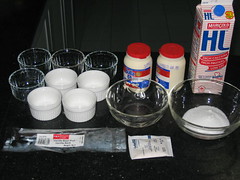
Notes on ingredients: Gelatine measurements differ from brand to brand, and some of you may opt for gelatine sheets instead, but basically you want enough gelatine to set 500ml of liquid, even though you have about 850ml. This is because the cream will set slightly when cooled. Even if you can't get heavy cream, just use single/whipping cream and do not change the amount of gelatin. Vanilla pods can be bought from specialty stores like Culina or Phoon Huat. Ramekins can be bought from Shermay's Cooking School.
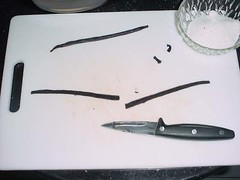
Remove the seeds from your vanilla pod by splitting the pod in half and scraping them out with a knife.
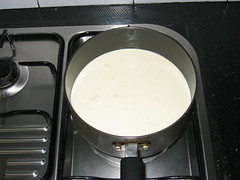
In a large saucepan bring cream, milk and sugar just to a boil over moderately high heat, stirring. Do not let your mixture boil vigorously as your cream might curdle.
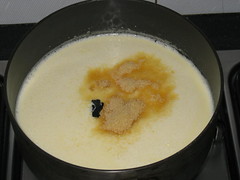
Remove pan from heat and stir in gelatine and vanilla with a whisk. Make sure all the gelatine has dissolved, and that there are no lumps remaining.
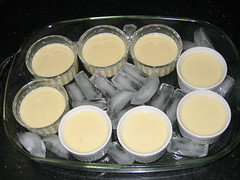
Strain through a sieve into 8 ramekins or martini glasses, in order to remove all the burnt vanilla seeds and undissolved gelatine, and cool in an ice bath to room temperature. Chill containers, covered, in a refrigerator for 4 hours or overnight.
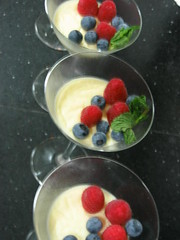
If serving in situ, simple spoon the strawberry compote onto the surface of the panna cotta, or even simpler, serve with fresh berries and a sprig of mint.

If unmoulding, run a knife round the edge of the panna cotta, and let the container sit in warm water to expand. Never use hot water or your panna cotta will melt. After two minutes, invert the container onto a plate and thump it a bit to dislodge the panna cotta. Spoon the strawberry compote over and garnish with syrup, chocolate sauce, mint and other such decorations. Your panna cotta should be wobbly, balanced delicately being a solid jelly and liquid cream, so that it melts tantalisingly in your mouth. If for any reason you don't achieve this, fiddle with the milk and cream measures: more milk to make it less firm, and less milk to make it more so.
Technorati Tags: Recipes, Panna Cotta
No comments:
Post a Comment